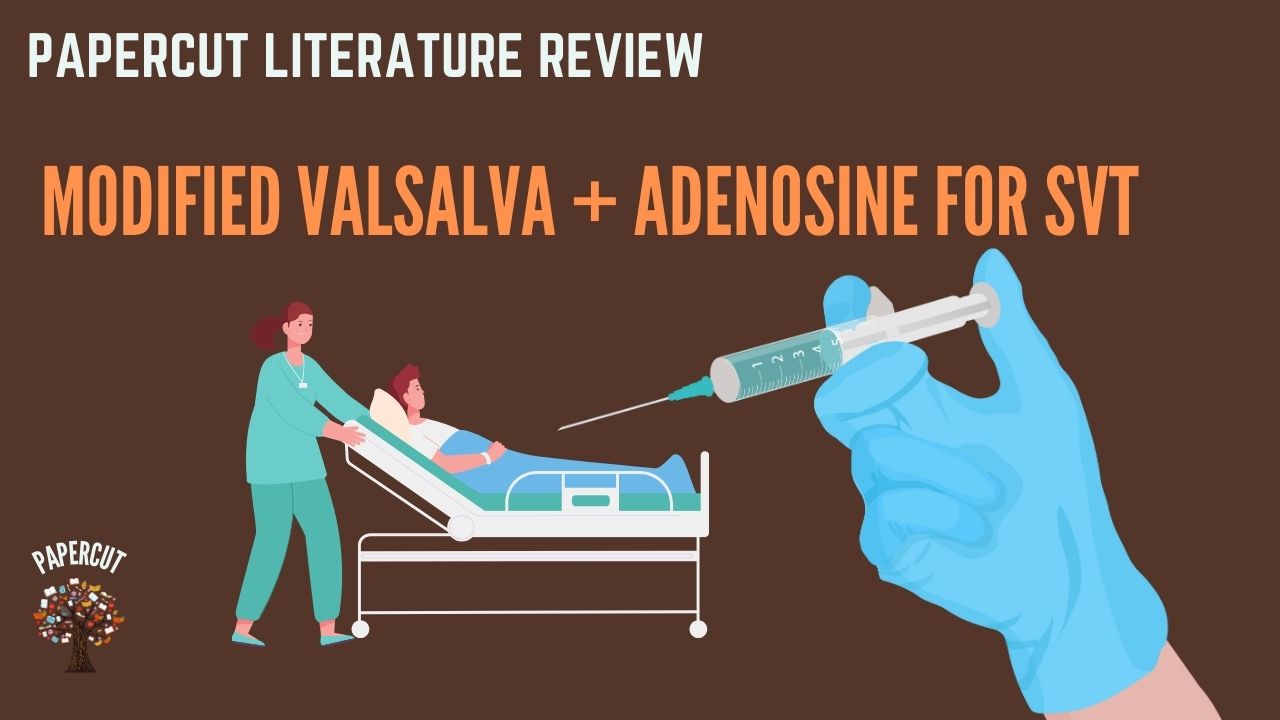Paroxysmal Supraventricular Tachycardia (PSVT), is a non-ischaemic tachyarrhythmia, with which patients, not uncommonly, present to the emergency department. Methods currently available for reversion to sinus rhythm include the Valsalva manoeuvre or the use of Adenosine. Neither has a 100% success rate in reversion.
This study(1) looked at the safety and efficacy of combining both therapies.
What They Did
This was a prospective, randomised, controlled trial.
N = 118
Patients were randomly assigned to one of three groups:
- Modified Valsalva Manoeuver (N = 38)
- IV Adenosine (N = 44)
- Combination therapy (N = 36)
Patients were included if they were:
- 14 -70 years old
- Had supraventricular tachycardia
- onset 5 minutes to 10 hours
- heart rates ranging from 150 – 246 bpm
Exclusion criteria included:
- New York Heart Association III or IV
- Haemodynamic instability
- Unstable angina
- MI within 3 weeks
- Had received an anti-arrhythmic within 1 week.
- Were allergic to Adenosine
- Had a contraindication to Valsalva (eg coarctation of the aorta) or could not tolerate the procedure
- PSVT recurred within 5 minutes of cardioversion.
Treatment was divided into the three groups
Group 1: Modified Valsalva Manoeuvre
This is the REVERT manoeuvre(2):
- Patients are in a semi-recumbent position,
- They are asked to exhaled forcefully through the 10 ml syringe to achieve a pressure of 40 mmHg pressure for 15 seconds, then
- They are moved to a supine position with lower limbs elevated to 45° to 90°, for 45 seconds.
The manoeuvre could be repeated a second time within 5 minutes.
Group 2: IV Adenosine:
This was given in increasing doses (5 minutes apart) of 6mg, 12mg and 18mg, with a 20ml bolus of normal saline to flush.
Group 3: Combination Therapy
Adenosine was given at the beginning of exhalation into the syringe.
 Adverse events were also monitored and included:
Adverse events were also monitored and included:
- Arrhythmias, lightheadedness and chest tightness
- Longest RR interval (pauses)
- Heart rate 1 minute following cardioversion
What They Found
First attempt versus total success rates were:
- Valsalva Group: 24% vs 42%
- Adenosine Group: 30% vs 75%
- Adenosine Plus Valsalva: 50% vs 86%
These results were not statistically significant.
 There was no major difference in adverse events, nor was there a difference in the average dose of Adenosine required.
There was no major difference in adverse events, nor was there a difference in the average dose of Adenosine required.
Authors’ Conclusion
“In conclusion, our study suggested that the combination of MVM and adenosine has higher success rate in the treatment of proximal supra- ventricular tachycardia. There are no significant adverse events from the combination therapy. However, there is no sufficient evidence to support the superiority of combination therapy over adenosine alone.”
My Take on This
This is a small study, with little information on the methodology. Although it shows differences in the success rates when a combined approach is used, they are not statistically significant. It would have been of interest to have a blinded arm, where Valsalva plus Adenosine versus Valsalva plus Placebo was also looked at.
I would have also been interested to see how the patient would have tolerated having the effects of Adenosine (impending doom) occur, whilst having the revert manoeuvre performed.
This won’t change my practice. I will start with a vagal manoeuvre (I prefer the reverse vagal manoeuvre) and if this is not successful, I usually proceed to Adenosine 12mg in a 20 mL syringe made up to 20mL with saline and inject as a rapid bolus.
This review first appeared on EM Mastery
References
- Xiao, L., et al. Combined modified Valsalva maneuver with adenosine supraventricular tachycardia: A comparative study. The American Journal of Emergency Medicine, 78, 157–162. PMID: 38281376.
- Appelboam A, et al. Postural modification to the standard Valsalva manoeuvre for emergency treatment of supraventricular tachycardias (REVERT): a randomised controlled trial. Lancet. 2015;386 (10005):1747–53.










